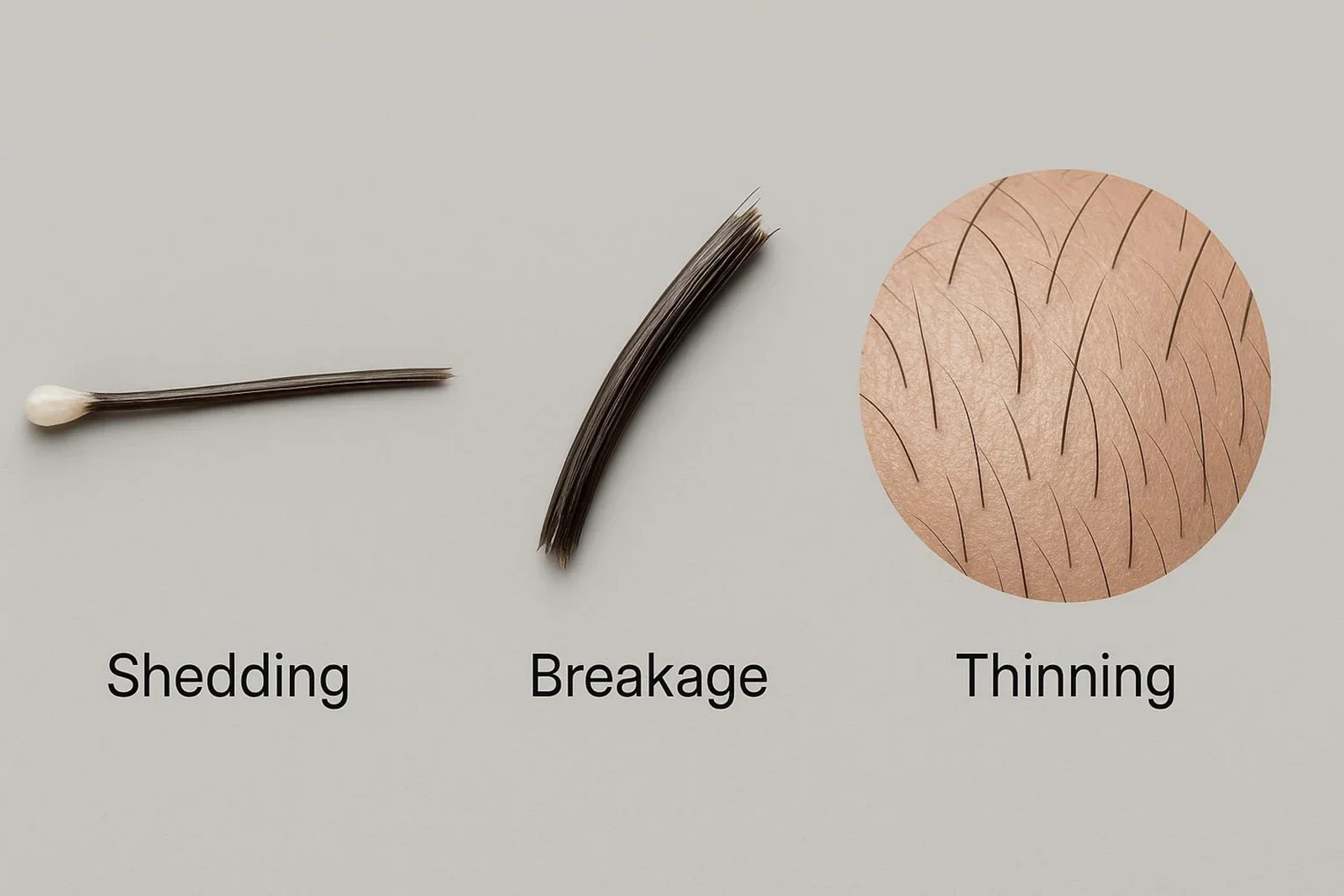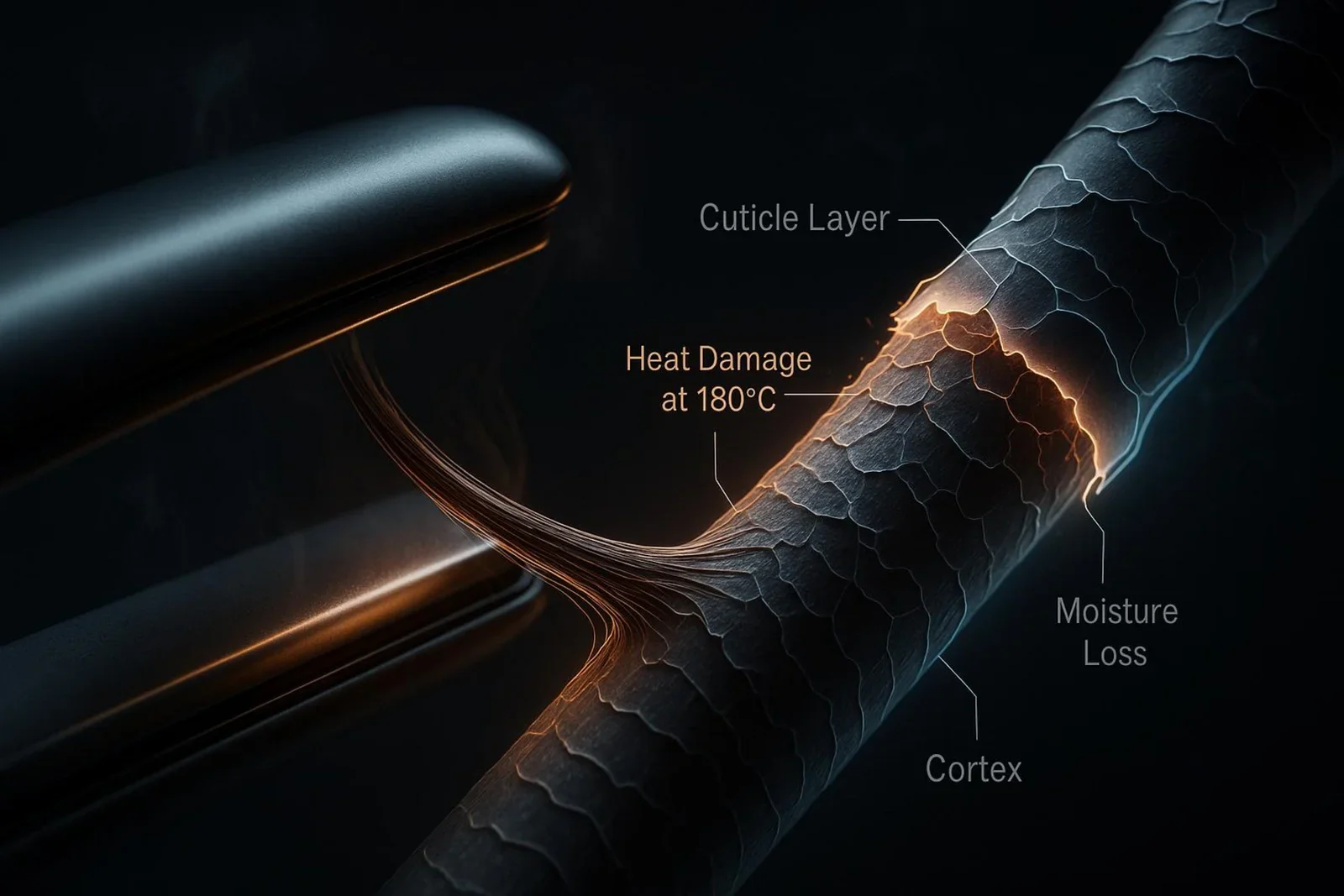Stop the Snap: How to Prevent Hair Breakage for All Hair Types
Hair breakage-when strands snap along their length instead of shedding from the root-is a common problem. It’s more than losing a few hairs. It shows up as stubborn split ends, surprise frizz, and the feeling that your hair won’t grow past a certain point. The upside: you can do a lot to cut down on breakage by reviewing your routine and making a few smart changes. When you know what causes it and use the right methods and products, you can reduce damage and bring back a healthy, glossy look.
This guide explains hair breakage from start to finish: what it is, what causes it, how to spot it, and how to fix your habits for every hair type. We’ll cover gentle washing, smart styling, protective looks, and product picks so you have clear steps to build stronger, more resilient hair.
What is hair breakage?
Hair breakage happens when a strand snaps somewhere along its length instead of falling out from the root naturally. Imagine a thin thread that gives way under stress. This is different from shedding, where a full strand slips out at the root to make room for new growth. Breakage signals that your hair has taken on too much wear and tear and its inner structure has weakened.
Your hair’s strength depends on the cuticle, a shield of overlapping scales that protect the strand. Heat, chemicals, and rough handling can lift or chip these scales. Once the cuticle is harmed, hair loses moisture, turns dry and brittle, and starts to split. The result is hair that looks dull, feels rough, and breaks more easily.
What does hair breakage look like?
Sometimes breakage can be hard to spot at first. Look for these common signs:
Persistent frizz and a rough texture
Ragged, thin, or uneven ends with lots of splits
Short, wispy bits that stick out, especially around the hairline
Pieces that look blunt or jagged (broken hair) rather than tapered (new growth)
Frizz often means the cuticle is lifted, which makes hair rough and easier to damage. Uneven ends and short pieces mixed in with longer strands point to hair snapping at different points.
How is breakage different from hair shedding or thinning?
These are three separate issues with different causes. Shedding is normal-most people lose 50-100 hairs a day from the root as part of the growth cycle and you’ll see a white bulb at one end.
Breakage is snapped hair along the shaft with no root attached. You’ll find shorter pieces in your brush, on your shoulders, or in the shower. This often stems from heat, chemicals, or rough handling.
Thinning means fewer hairs growing in total or finer individual strands. It can be tied to genetics, hormones, diet gaps, or health issues. Severe breakage can make hair look thinner, but thinning is mostly about the number of active follicles or strand thickness. If hair loss or thinning seems heavy, talk to a healthcare professional to find the cause.
| Issue | What you see | Main cause |
|---|---|---|
| Shedding | Full strands with a white bulb | Normal growth cycle |
| Breakage | Short pieces, jagged ends, no bulb | Damage to the hair shaft |
| Thinning | Less density or finer strands | Genetics, hormones, health, nutrition |
Where can breakage occur and what are the signs?
Breakage can show up anywhere on the head. The pattern often points to the cause, which helps you adjust your routine.
At the crown and root
Tight ponytails, buns, and updos can strain the crown, leaving short, snapped hairs that stick up and look fuzzy. For coily hair (Type 4), especially 4c, tight braids or twists can stress hair at the crown and lead to breakage.
Root breakage can happen with very tight styles or heavy extensions. New growth may look uneven or much shorter. In curly hair, you might see extra frizz close to the scalp where strands are stressed as they grow out.
Around the hairline and temple
The hairline is delicate and breaks easily. Pulling styles, friction from hats or headbands, and frequent touching can all play a part. You may see short, fine hairs at the edges, which can look like thinning or patchiness. Tight cornrows and slicked-back styles can lead to traction alopecia in curly or coily hair.
The temples are also at risk, especially if you often wear pulled-back looks or tuck hair behind your ears. Glasses can add rubbing at the temples and cause breakage there.
At the ends and mid-lengths
Ends are the oldest part of your hair and break first. Split ends and thin tips signal damage here. Once the cuticle is worn down, the inner cortex frays and splits can travel up the strand. Regular trims help stop this spread.
Mid-length breakage often comes from rough brushing, hot tools, or harsh chemicals. A “halo” of shorter hairs on top can point to over-brushing or too much heat. This is common if you straighten chemically or use high heat often.
Frizzy, uneven strands and split ends
Frizz means lifted cuticles, which makes hair look dull and feel rough. Short, mixed-in pieces break up the shape and make sleek styles harder to get. Split ends are a clear sign of damage. You can’t fuse them back together, but trims and rich treatments help stop new splits and keep hair looking smooth.
How does breakage affect different hair types?
All hair can break, but texture and shape change how it shows up and what it needs.
Straight hair (type 1)
Straight hair looks smooth, and natural oils travel down the strand more easily. This helps with moisture but can lead to buildup. Heat and chemicals still cause split ends and thin tips. Over-brushing, especially when wet, can snap strands and leave small broken bits that dull the finish. Be gentle, use lower heat, and get regular trims.
Wavy hair (type 2)
Wavy hair has bends that tangle more easily. Rough detangling can snap mid-lengths. Ends can dry out, raising the risk of splits. You may notice less wave definition, more frizz, and short pieces breaking the flow. Hot tools used often can add to the damage without heat protection and the right settings.
Curly hair (type 3)
Curly hair is drier by nature because oils from the scalp don’t travel as easily around coils. It breaks more if handled roughly or kept dry. Breakage can happen at the root (tight styles), on top (over-manipulation), and at the ends (dryness and splits). Signs include lost curl shape, more frizz, and brittle feel. Gentle care, deep moisture, and low-tension styles help a lot.
Coily hair (type 4)
Coily hair has very tight patterns that hold less moisture along the length. It tangles easily and is the most fragile. Breakage often shows at the crown with tight protective styles, at the root with heavy pulling, and at the ends from dryness. You may see thinning at the hairline and temples and slow length gains. Keep moisture high, handle gently, and choose loose, low-tension protective styles.
What causes hair breakage?
Breakage usually comes from a mix of habits and stressors that weaken strands over time. Knowing the main triggers is the first step to stopping them.
Heat styling and thermal damage
High heat from blow dryers, flat irons, and curling irons dries out hair and lifts the cuticle, which weakens the strand. The more often and hotter you go-especially without heat protectant-the more damage builds. Give hair breaks between heat sessions and always use a protectant.
Chemical treatments and overprocessing
Perms, relaxers, and straightening services change your hair’s structure and can weaken it. Too-frequent sessions or incorrect application break down the cuticle and strip moisture, leaving hair dry and brittle. Give hair plenty of time to recover between services. The American Academy of Dermatology (AAD) suggests spacing sessions 8-10 weeks apart when you can and adding extra repair and hydration to your routine.
Colouring and bleaching hair
Bleach lifts the cuticle to remove pigment, which exposes the inner structure and dries hair out. Frequent or dramatic lightening raises the risk of breakage. Regular coloring can also dry hair if done too often. If you’re breaking, pause color work until hair feels stronger. If you must color, try temporary dyes and follow up with bond-builders and rich hydration.
Over-washing and harsh detergents
Washing too often-especially with strong sulphate shampoos-strips natural oils that keep hair soft and flexible. Hair turns dry and snaps more easily. Most people don’t need daily washing. If your hair is dry, spread out wash days and choose hydrating, sulphate-free shampoo and conditioner. Use lukewarm water to avoid extra dryness.
Tight hairstyles and tension
Tight ponytails, buns, and braids pull on hair and scalp. Daily pressure in the same spot can wear strands down until they snap, often at the hairline and crown. Choose looser styles, use soft elastics or spiral ties, and rotate your hairstyles to reduce stress on the same areas.
Aggressive brushing and teasing
Rough brushing, especially through knots, yanks on strands and causes breakage. Wet hair is the weakest; the AAD advises against pulling at wet tangles with a standard brush. Teasing roughs up the cuticle and leads to damage over time. Detangle gently from ends to roots with a wide-tooth comb or a flexible-bristle brush, and use a leave-in for slip when needed.
Environmental stress and sun exposure
UV rays dry and weaken hair, fade color, and raise breakage risk. Wind, pollution, and dry air also sap moisture. Use hats, scarves, and UV-protective hair products when you’re outdoors to protect strands.
Diet, hydration, and nutritional deficiencies
Hair needs steady nutrients to grow strong. Gaps in protein, omega-3s, biotin, zinc, iron, and folic acid can leave hair weak and brittle. Not drinking enough water adds to dryness. NHS guidance suggests at least two litres of water daily. Without the right building blocks, hair grows slower and breaks more easily.
Hormonal changes and life stages
Shifts in hormones-like during pregnancy or menopause-can change hair texture and growth patterns, sometimes raising breakage. Low thyroid function can also cause damage and shedding. If breakage comes with symptoms like fatigue, weight changes, or low mood, see a healthcare professional.
Sleep habits and friction
Rubbing on rough pillowcases creates friction that tangles and snaps strands over time. Sleeping with wet hair increases friction damage because swollen, wet cuticles are easier to harm. Tight sleep gear can also pull on hair. Small changes at night can help protect your hair.
What can you do to prevent hair breakage?
Prevention comes from gentle care, smart product picks, and consistent habits. Add these steps to your routine to help stop snapping and build strength.
Cleansing gently and limiting wash days
Spread out washes if your hair is dry or brittle. Dry shampoo can refresh roots between wash days. Pick a hydrating, sulphate-free shampoo and conditioner. For example, L’Oréal Paris Elvive Hyaluron + Plump Hydrating Shampoo uses hyaluronic acid to boost moisture. Massage the scalp with fingertips, don’t scrub lengths, and let rinse water run through the ends. Use lukewarm water to help keep moisture in.
Choosing the right conditioner and nourishment
Conditioner is a must after every shampoo. Focus on mid-lengths and ends. Pairing L’Oréal Paris Elvive Hyaluron + Plump Hydrating Conditioner with the shampoo helps with detangling, shine, and hydration for up to 72 hours.
Add weekly treatments. Use a mask once or twice a week-leave it on longer, even overnight, for extra benefits. Look for masks with proteins (keratin), vitamins, oils (argan, shea), and moisturizing ingredients. Squeeze out excess water before applying and spread evenly with a wide-tooth comb. A warm towel can help the mask sink in.
Protecting hair from heat
If you use hot tools, always apply a heat protectant first. Products like L’Oréal Paris EverPure Sulfate-Free Blow Dry Primer or L’Oréal Paris Elvive Dream Lengths Heat Slayer Leave-In protect up to 450°F/230°C.
Use the lowest setting that still gets the job done. If your tool has Variable Temperature Control-like the CLOUD NINE 2-in-1 Contouring Iron Pro-use a temperature guide to find the right heat for your hair. Air-dry to about 75% before blow-drying to reduce total heat time. Tools with mineral-infused ceramic plates help spread heat evenly and keep more moisture in.
Drying hair with care (microfibre towels, old T-shirts)
Wet hair breaks more easily. Skip rough terry towels and hard rubbing. Use a microfibre towel or a soft cotton T-shirt. Gently blot to remove water. For wavy and curly hair, press and twist softly. These fabrics cut down on friction, reduce frizz, and speed up drying in a gentler way.
Detangling tips for all hair types
Gentle detangling is key. Don’t yank through knots, especially when hair is soaking wet. Start at the ends and work up to the roots. Use a wide-tooth comb or a detangling brush with flexible bristles. For stubborn knots, add a leave-in or detangler-like L’Oréal Paris EverPure Sulfate-Free Moisture 21-in-1 Leave-In Conditioner-for extra slip. Curly and coily hair often detangles best when damp and coated with conditioner or leave-in.
Choosing protective hairstyles and reducing tension
Reduce daily pulling by wearing looser styles. Switch between a messy ponytail, low bun, braid, and half-up looks across the week. Replace rubber bands and metal clasps with silk scrunchies, spiral ties, or soft elastics. Claw clips hold hair without stress. Protective styles help when done loosely and not kept in too long.
Routine trims and split end prevention
Split ends don’t fuse back together, so trims stop them from creeping up the strand. Micro-trims every 6-8 weeks keep ends healthy and can help you grow longer hair over time. If damage is heavy, a cut gives you a fresh start.
Between trims, hydrate ends with leave-ins and oils. Try CLOUD NINE Magical Remedy or Wella ULTIMATE REPAIR Miracle Hair Rescue to strengthen brittle hair (they won’t seal existing splits). Growing your hair? Ask about a “Cut & Seal Service” that targets splits while keeping length.
Night-time protection: silk pillowcases, bonnets, and braids
Swap cotton pillowcases for silk or satin to cut friction and keep moisture in. If that’s not an option, wrap hair in a silk or satin bonnet or scarf. Curly hair can “pineapple” (gather curls loosely on top with a silk scrunchie) to save curl shape. A loose braid helps all hair types reduce tangles while you sleep.
Diet and nutrition for stronger hair
Feed your hair from the inside. Eat enough protein (hair is mostly keratin): lean meats, fish, eggs, and legumes are good sources. Add nutrients that support hair: omega-3s (salmon, flaxseeds), biotin (eggs, nuts, sweet potatoes), zinc (meat, shellfish, legumes), iron (spinach, lentils, red meat), folic acid (leafy greens, citrus), and vitamin D. Drink at least two litres of water daily, as the NHS recommends, to help keep hair hydrated.
Best products to help reduce and repair hair breakage
Along with better habits, the right products play a big role in strengthening, hydrating, and protecting your hair.
Leave-in conditioners and treatments
Leave-ins give ongoing moisture, help with tangles, and add a light shield against daily wear. They’re especially helpful for curly, coily, frizz-prone, or dry hair.
L’Oréal Paris EverPure Sulfate-Free Moisture 21-in-1 Leave-In Conditioner softens knots and adds hydration. CLOUD NINE Magical Remedy works as a rinse-out, leave-in, or deep treatment. Wella Professionals NutriCurls Milky Waves Nourishing Spray adds lightweight moisture with Nourish-In Complex, jojoba oil, and panthenol and makes detangling easier.
Bond-building and strengthening masks
If your hair is damaged, bond-builders and strengthening masks help repair internal bonds and shore up weak spots. They’re especially helpful if you color, bleach, or use chemical services.
L’Oréal Paris EverPure Bond Repair (pre-shampoo, shampoo, conditioner) supports damaged bonds and reinforces strands. Wella Professionals ULTIMATE REPAIR promises up to 99% less breakage, using AHA to refine the cuticle and Omega-9 to smooth and fill the outer layer. Wella Fusion, with amino acids, makes hair up to 95% more resilient. Use masks like Fusion Intense Repair Mask or ULTIMATE REPAIR Mask once or twice a week.
Recommended oils and serums
Oils and serums seal in moisture, add shine, and give extra protection at the ends. They’re especially helpful for Type 3 and Type 4 hair. Argan, coconut, and jojoba oils work well on the ends to help prevent splits.
Wella Professionals ULTIMATE SMOOTH Miracle Oil Serum adds moisture and smoothness for up to 3 days and includes a UV shield. It’s light enough for wet or dry hair and good for topping up between washes. For night care, a few drops of a keratin-rich serum like Virtue Healing Oil can help ends stay soft and flexible. Start with one or two drops and build up as needed, especially on fine hair.
Flexible bands, wide-tooth combs, and brushes
Choose tools that are gentle. Swap harsh bands for silk scrunchies, spiral ties, or soft elastics. Claw clips hold hair without pulling.
Use a wide-tooth comb for wet hair. For dry hair, a brush with soft, flexible bristles-like the CLOUD NINE Luxury Dressing Brush-helps detangle and spreads natural oils. Avoid hard plastic bristles. Always detangle from ends to roots.
Heat styling tools with adjustable temperature
If you use hot tools often, picking models with adjustable heat helps reduce damage. The CLOUD NINE 2-in-1 Contouring Iron Pro offers Variable Temperature Control and Revive Mode with Axial Vibration Technology™ to cut friction and help prevent breakage. All CLOUD NINE Irons and Wands use ceramic plates for even heat and better moisture retention.
Pick the lowest heat that works for your hair, even if styling takes a bit longer. Always pair tools with a heat protectant. Wella Professionals EIMI Thermal Image is a light mist that protects up to 230°C/450°F if you want a weightless shield.
Frequently asked questions about hair breakage
How much breakage is normal?
A small amount of breakage happens to everyone. Losing 50-100 hairs a day from natural shedding is also normal. But if you keep seeing lots of short, broken pieces, constant frizz and dullness, or your hair won’t grow past a certain length, you may be dealing with more breakage than usual. If you notice clumps, thinning, or bald spots, see a doctor or a pro stylist to rule out other issues.
Can you fully repair split ends?
No. Once a strand splits, you can smooth it for a short time, but the split is still there. Bond-builders and rich masks can strengthen the rest of the strand and help prevent new splits. The only real fix is a trim. Regular trims remove damage before it travels up the hair shaft and help keep your hair healthy overall.
Which hair type is most at risk for breakage?
Coily hair (Type 4) breaks the most because tight coils keep natural oils from moving down the strand, which leads to dryness and higher fragility. Curly hair (Type 3) also leans dry and breaks more easily than straight or wavy hair. Fine hair, especially if heavily processed, can be fragile too.
How long does it take to see stronger, healthier hair?
Change takes time and steady care. You may see early improvements in a few weeks-less frizz and easier styling. For hair that feels stronger and looks clearly healthier, give it 3-6 months. A full hair growth cycle is about 6-12 months, so patience pays off. Keep up gentle care, nourishing products, and protective habits for the best results.
Do you live in Sydney?
Get the perfect look at our salon – schedule your appointment now!
Our Services
Check Out Our Instagram
Check out our instagram
Check out our instagram and see our latest posts!
Check out our facebook
Check out our facebook and see our latest
posts!













